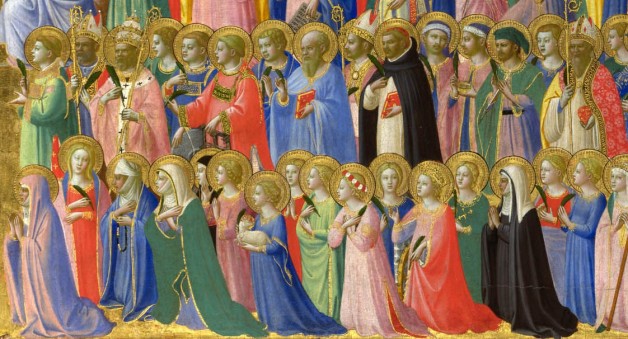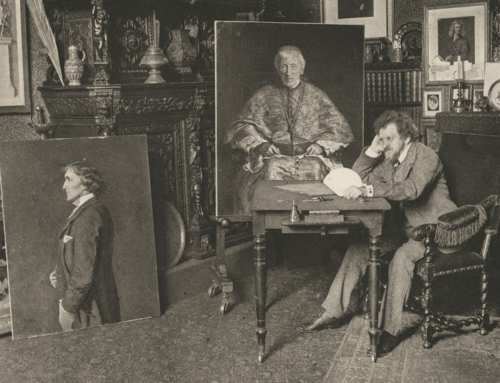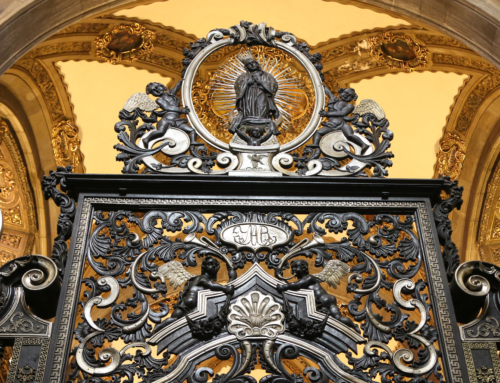Bl. John of Fiesole, better known as Fra Angelico, was one of the great painters of the early Renaissance. Many people don’t realize, however, that he was also a Dominican friar, and a very holy friar, too.
He and his brother, Fra Benedetto, entered the Dominican Order in their mid-twenties. Both were already skilled artists. Although Benedetto produced some of the finest illuminated manuscripts in Europe, Angelico has always been the more famous of the two, being especially noted for the frescoes he painted at San Marco, the Dominican convent and church in Florence. Michelangelo, who lived a few generations later, positively revered Angelico and his work. He even carved a statue of the risen Christ to be placed by Angelico’s tomb and said of him, “He has gone to meet those whom he painted.”
Angelico was a tireless worker and finished a great number of paintings in his lifetime, but, thinking it would somehow be against God’s will, he never retouched or reworked any of them. He always prayed when he painted, and he would say, “To paint the things of Christ, one must live with Christ.” In Vasari’s Lives of the Artists, there is this description of him:
He was never seen in anger among his fellow friars, which is a very notable thing, and almost impossible, it seems to me, to believe; and it was his custom to admonish his friends with a simple smile. With incredible sweetness, if any sought for works from him, he would say that they had only to gain the consent of the Prior, and that then he would not fail them.
His epitaph, written by Pope Nicholas V, runs as follows:
NON MIHI SIT LAUDI, QUOD ERAM VELUT ALTER APELLES,
SED QUOD LUCRA TUIS OMNIA, CHRISTE, DABAM;
ALTERA NAM TERRIS OPERA EXTANT, ALTERA CAELO.
URBS ME JOANNEM FLOS TULIT ETRURIAE.Let not the praise be mine that I was like another Apelles,
But rather that I gave all my gain to your people, O Christ;
For some works are manifest on earth, others in heaven.
The city which is the flower of Tuscany bore me, Giovanni.
Angelico’s works have a wonderful luminosity and graceful innocence about them. Perfect evocations of purity and holiness, they are also entirely natural, free of any pretension or insincerity. In the musical realm, we might compare them to one of Mozart’s adagios, or a Palestrina motet. In the world of literature, however, they remind me—and the connection may at first seem strange—of the writings of J.R.R. Tolkien.
Why? Perhaps it’s because both Tolkien and Angelico manage to convey a vivid sense of the supernatural and, at the same time, remain realistic. (Indeed, isn’t this part of the genius of the medieval period, by which Tolkien was so inspired?) More precisely, though, both Angelico and Tolkien express the joy, touched with longing, of a sacramental vision of reality—of seeing God as operative in, and just behind the veil of, this created world. Take, for example, this passage from The Fellowship of the Ring, all the more significant for being echoed at the very end of the trilogy:
That night they heard no noises. But either in his dreams or out of them, he could not tell which [cf. 2 Cor 12:3], Frodo heard a sweet singing running in his mind: a song that seemed to come like a pale light behind a grey rain-curtain, and growing stronger to turn the veil all to glass and silver, until at last it was rolled back, and a far green country opened before him under a swift sunrise.
The vision melted in waking; and there was Tom whistling like a tree-full of birds; and the sun was already slanting down the hill and through the open window. Outside everything was green and pale gold. (Chapter 7)
Communion with the unseen world imbues this world with enchantment and points us toward that glory which created things both reveal and conceal. Angelico’s radiant figures and Tolkien’s “scrubbed morning world” (as one reviewer put it) convey something of this truth. Both are lit with the light of faith.
✠
Banner Image: Fra Angelico, The Forerunners of Christ with Saints and Martyrs
Click an image below to begin slideshow.







